In the New World there are seven species of birds that belong to the vulture family. Three of these species are present in the United States: the Turkey Vulture, the Black Vulture, and the California Condor. Two of these three are present in Ohio: the Turkey Vulture and the Black Vulture.
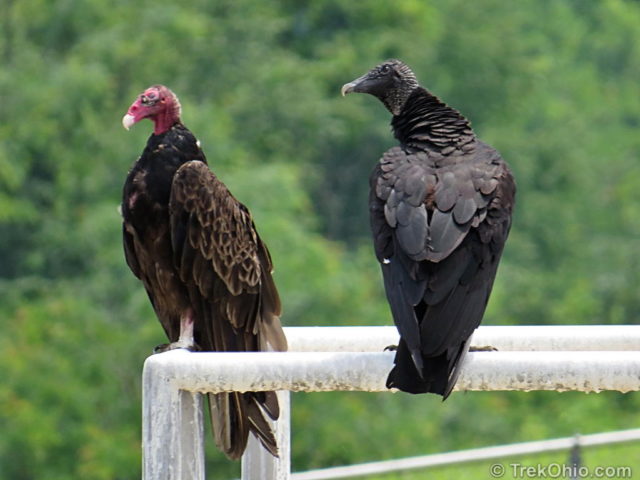
Finding Food
The most noticeable difference between the two species is the color of the head: red for Turkey vultures and dark gray for the Black vulture. The bills are also colored differently. The Turkey vulture has a white bill, and the Black vulture has a dark bill. However to complicate matters, the juvenile Turkey vulture resembles the Black vulture in having a dark head and bill. So let me draw your attention to a couple of other differences. The Turkey vulture has dark brown plumage, while the Black vulture has black feathers. But if you can see the head of the bird, the size of the nostrils is very different between the two. The turkey vulture has huge nostrils whereas those of the black vulture are not particularly noticeable. The large nostril seen in the photo below tells me that this dark-headed vulture is a young turkey vulture.
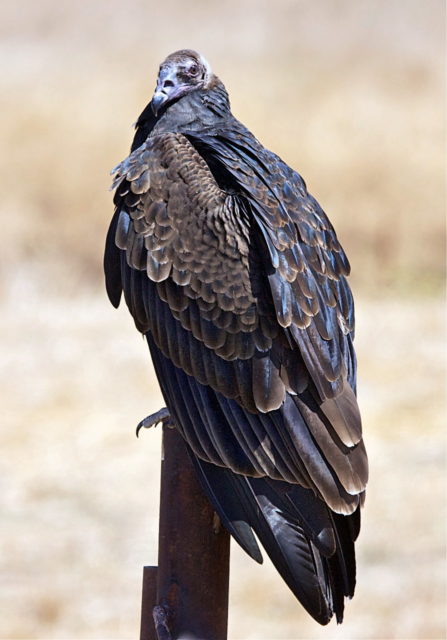
Juvenile Turkey Vulture with dark head, but note the distinguishing, large nostrils.
The Black vulture is unable to detect the scent of dead animals from the air. However besides having big nostrils, Turkey vultures also have a keen sense of smell. The portion of the Turkey vulture’s brain that’s dedicated to interpreting smells is also unusually large. The scent that attracts a Turkey vulture to its food is ethyl mercaptan. This is a chemical by-product of decay, and the turkey vulture’s sense of smell is so sensitive that it can detect this chemical from animals that have recently died.
Turkey vultures prefer their food to be as fresh as possible. Captive birds eagerly eat fresh meat and studies have shown that they don’t have much of an appetite for meat that’s four days old or older. Nonetheless Turkey vultures and Black vultures have unusually strong stomach acid that destroys all the pathogens in the meat that they eat, essentially sanitizing it.
Since Black vultures cannot locate food using their sense of smell, Black vultures sometimes hang out with Turkey vultures. When seeking food Turkey vultures tend to fly just above a forest canopy trying to pick up its scent. Black vultures often soar above the Turkey vulture, waiting for the Turkey vulture to find some food.
The word, “vulture” is derived from the Latin word vulturus, which means “tearer”. This is supposed to describe the way that vultures tear pieces of meat from the carrion that they find. However the vultures of the Old World (Europe, Asia, and Africa) have stronger bills and are better tearers than those in the New World (North and South America). But among New World vultures, the Black vulture has a stronger bill and is better at tearing food than the Turkey vulture.
Turkey vultures generally eat alone or hierarchically. If more than one Turkey vulture is gathering around a food source, the dominant male eats by himself first, then whoever is next in line in the hierarchy eats second, and so on. In contrast Black vultures frequently approach their food as a flock. By pulling the carcass in opposite directions at the same time they increase their chances of successfully opening it up.
The relationship between Turkey vultures and Black vultures is sometimes described as one of mutual dependence. The Black vulture benefits from the Turkey vulture’s ability to find food. However the Turkey vulture is supposed to benefit from the relationship because the Black vulture can tear open hides that are too tough for a Turkey vulture. Once the hide has been opened, the Turkey vulture can also eat it. However there’s a potential problem with this arrangement as far as the Turkey vulture is concerned.
When a Turkey vulture finds food that its capable of eating by itself, Black vultures will sometimes bully the food away from it. A single Turkey vulture can hold off a single Black vulture because the Turkey vulture is bigger. However Black vultures are more aggressive and often travel in flocks. If a flock of Black vultures wants first crack at a Turkey vulture’s food, they’ll get it.
Another behavior that distinguishes Turkey vultures from Black vultures is that Black vultures are willing to wade into shallow water to pick up floating carcasses of fish or animals. Surprisingly both Turkey vultures and Black vultures have a slight amount of webbing between their two front toes.
Black Vultures as Predators
Although Turkey vultures restrict their diet to carrion, Black vultures are able to prey on living animals, especially newborns. Black Vultures can even take down animals that are much bigger than any prey that a Great Horned Owl or Eagle would attempt. In particular Black vultures are known to attack and kill young calves. A flock of Black vultures accomplishes this by pecking at the young calf’s eyes, nose, and tongue. If the vultures are not stopped, the calf will go into shock and fall down. Once this happens the Black vultures proceed to eat it in the same way that they would eat carrion.
Farmers cannot legally shoot vultures that are harassing their livestock because they are protected by the 1918 Migratory Bird Treaty. The government of Ohio used to indemnify farmers for their loss. However the state’s budget for that has since dried up, and now farmers are on their own.
I have not seen Black vultures in central Ohio where I live, but I have in southern Ohio. Recently while traveling through rural, southern Ohio we drove by a farm where there were a number of calf-sized shelters that reminded me of dog houses. A calf was tethered near each one. I found myself wondering if these were intended to give the calf somewhere to shelter in the event of a Black vulture attack.
A Face Only a Mother Could Love
Both Turkey vultures and Black vultures have bald heads. This prevents bacteria-laden gore from getting stuck in their feathers. In addition the skin on a Turkey vulture’s head is oily so that material will slip off of it. Both of these seem like excellent adaptations for carrion-eaters.
However Turkey vultures also exhibit a peculiarity that doesn’t seem to be adaptive, or if it is, no one has figured out its purpose. Turkey vultures get what looks like crusty gunk in front of their eyes. But this is not superficial material; it is a type of growth that’s usually referred to as “warts.” As the Turkey vulture gets older, it gets more and more warts.
Getting around
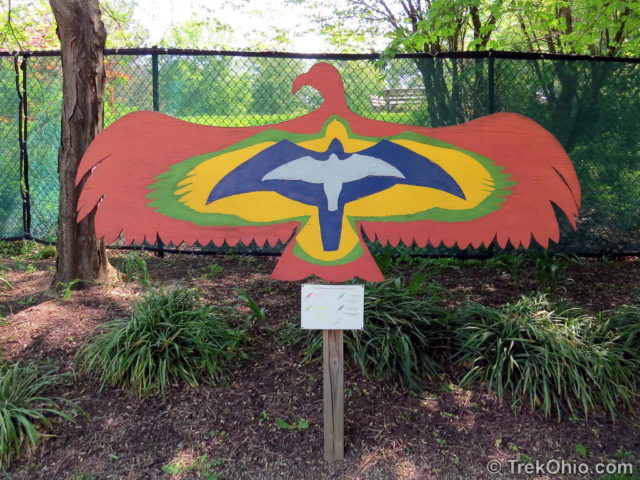
Of the two vulture species, the Turkey vulture has the larger wing span: 5 to 7 feet (1.5 to 2.1 meters). Not surprisingly it is also the better glider. Spreading its wings in a slight V-shape when viewed head on, it seeks out a thermal (a column of warm, rising air). Using this thermal the Turkey vulture circles up, up and up. Once it has ascended to a considerable height, the Turkey vulture can glide away from that thermal, gradually descending till it finds another one. In this way a Turkey vulture can soar over large distances while barely flapping its wings. Its use of thermals is so efficient that a Turkey vulture barely expends more energy flying than it does when it’s just standing. On a daily basis Turkey vultures spend about one-third of their day soaring.
In contrast Black vultures have a wingspan of 4.3 to 5.5 feet (1.3 to 1.7 meters). The Black vulture soars with its wings held horizontally, and it goes shorter distances while soaring than does the Turkey vulture. After a short period of soaring, the Black vulture has to engage in a burst of wing flapping, followed by another soar.
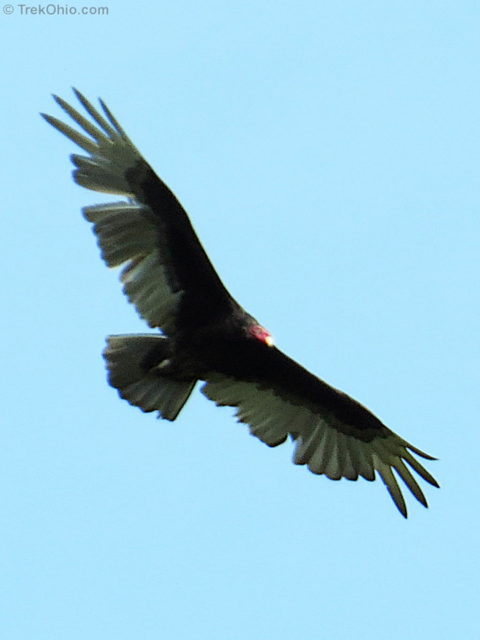
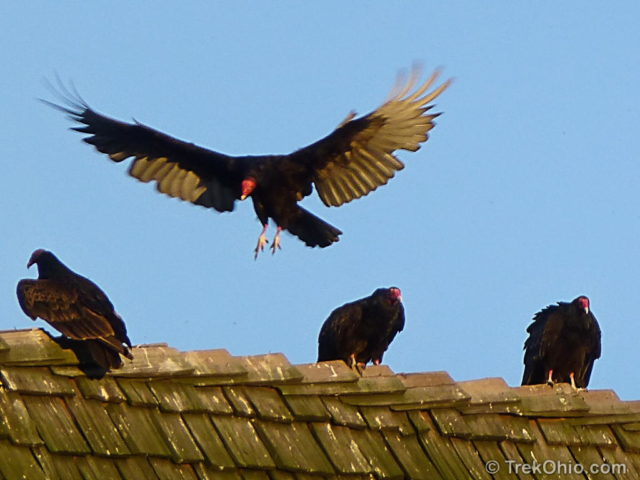
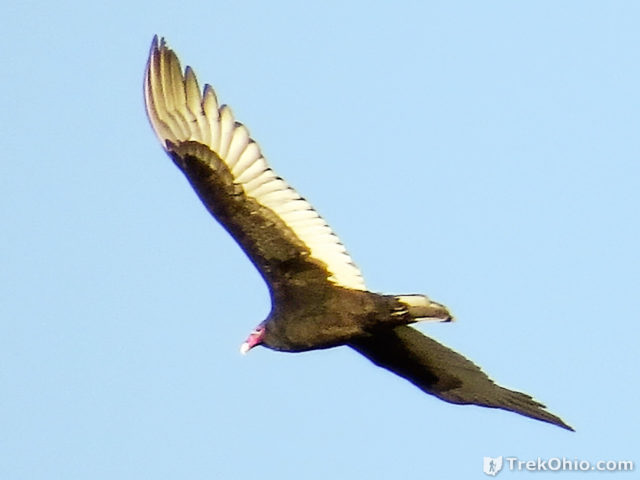
Note the unique coloration of the underside of the Turkey vulture in the photos above. The tail and the fringe of the wings are a silvery gray color that may look nearly white when it catches the light. The black vulture doesn’t have nearly as many light-colored feathers. Only the extreme wing-tips the Black vulture are light-colored when viewed from underneath as seen in the photo below.
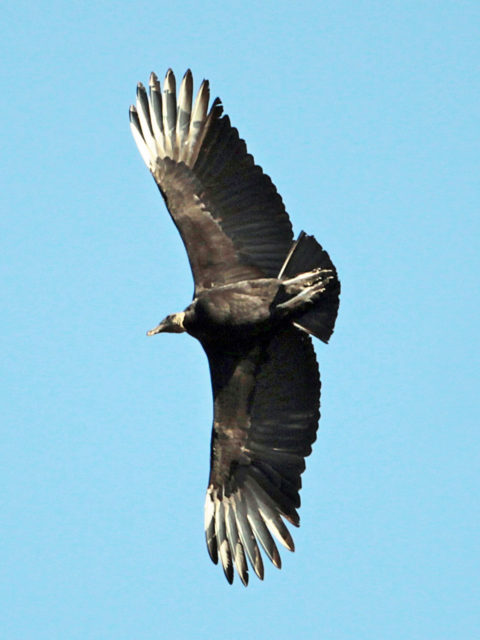
Turkey vultures and Black vultures have to land on the ground to eat, but launching themselves into the air from the ground is challenging. They are also awkward-looking when moving around on the ground. Although the Turkey vulture pictured below is clearly walking, both these vultures frequently engage in a sort of hopping walk.
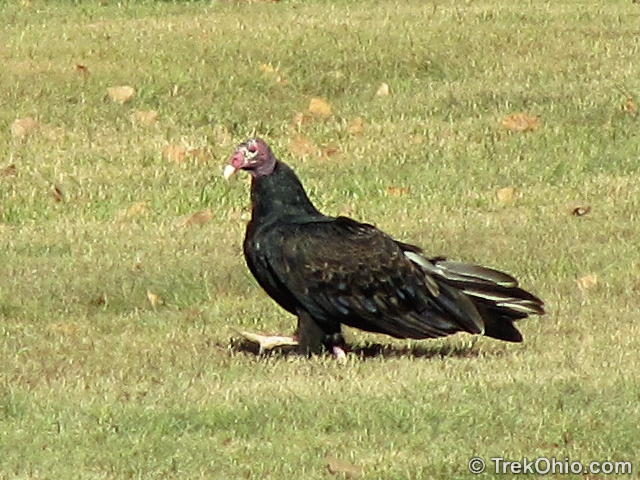
An Interesting Way to Keep Cool
In the previous photo of the walking Turkey vulture you may have noticed that its legs and feet look kind of white. However it’s legs are really a pink color. Similarly in the photo of the Black vulture below its legs look white, but they are really a dark gray. And you might recall that bird droppings are white. Then you might put two and two together and say, “Ewwwww….” Yes, it’s true; Turkey vultures and Black vultures allow their droppings to just run down their legs. Or I should say that they decide to let their droppings run down their legs if they are feeling too hot. Their aim is to take advantage of evaporative cooling.
Bird droppings consists of the bird’s urine and/or feces. It is the uric acid in their droppings that stains their legs white. Believe it or not, there is a word that describes the process of cooling down by soiling yourself: urohydrosis.
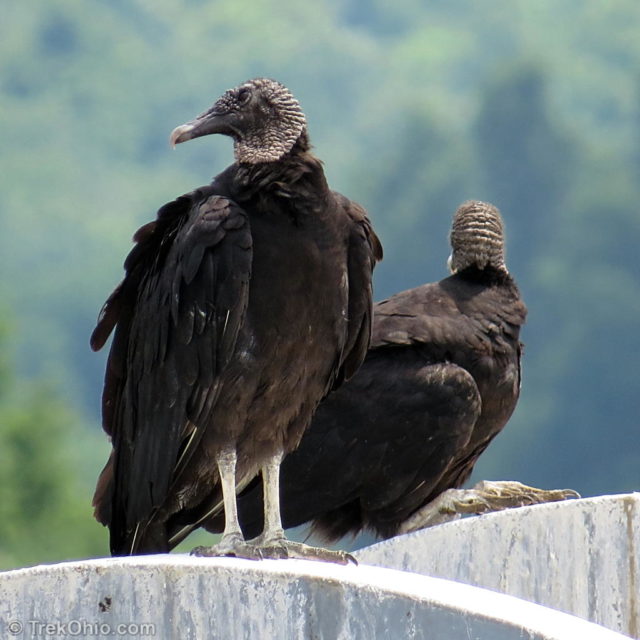
Because both species of vultures soil their legs regularly, researchers are not allowed to band their legs. Some of the droppings would become trapped inside the band, and this would cause leg lesions. However without banding these birds, it is much harder for researchers to understand their migratory behavior.
Strking a pose
Besides cooling themselves off, turkey vultures and black vultures also engage in an activity to warm themselves up. The bird below is standing with his wings outstretched in what’s known as the horaltic pose. It’s thought that this pose increases the amount of sunlight striking the bird’s body which warms the bird.
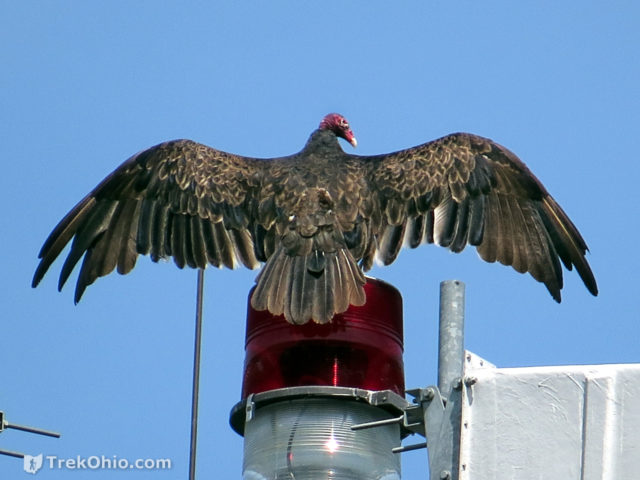
At night the internal body temperature of both species of vultures drops by about 9°F (5°C); this amounts to a normal kind of hypothermia. The advantage of lowering its temperature overnight is that the bird expends fewer calories keeping warm and thus needs fewer calories to live. But when the bird wakes up the following morning, its body temperature has to rise back up to its normal waking temperature. Scientists believe that by standing around with its wings outstretched in the morning, the vulture gets a little help from the sun.
Vultures are slow to get going in the morning. Besides going through a period of raising their body temperature, they also like to wait for the day to heat up a bit so that thermals will help them stay aloft without working too hard.
The vultures’ strange change in body temperature and the fact that vultures adjust their body temperature through their behavior makes vultures seem a bit reptilian to me. It’s as if they’re not as warm-blooded as the rest of us warm-blooded creatures.
However there are some other explanations for this outstretched pose that have nothing to do with temperature regulation. Some think this pose helps the vulture to dry its wings… assuming that they need to be dried. Others think the sunlight kills the bacteria that might be harboring in its feather. And maybe it’s doing all these things.
Nesting without a Nest
Neither the Turkey vulture nor the Black vulture bother building a nest for their eggs. Typically they just lay their eggs on the ground somewhere, although they have been known find a hollow tree. But in either case, the parents do not build a structure to cushion, contain, insulate or protect its eggs. However while not building a structure that has some practical application, Black vultures have been known to decorate their nesting area with little bits of shiny stuff or color. For instance a Black vulture might artfully arrange some bottle caps or pieces of broken plastic around its nesting area.
Despite not building a nest the mother does try to find an out-of-the-way place for her eggs, and both parents take turns incubating and guarding their eggs. Most egg-eating predators find the parents to be more than a little intimidating. However if intimidation doesn’t work, the protective parent does its signature move: it vomits on the would-be egg eater. Okay, ewww… again. Besides the stench and yuckiness of it all, vulture vomit can also sting. Remember that extra strong stomach acid? Ouch.
If that doesn’t work, the Turkey vulture has one more fall-back move: it pretends to be dead. I’m not quite sure why that works, but there you go. Maybe the predator thinks the vulture just died of whatever illness caused it to throw up on the predator, and so the predator thinks, “I better go get cleaned up!” 😀
The incubation period for both species of vulture is long. Turkey vultures incubate their eggs for 40 days. Black vultures incubate their eggs between 28 and 41 days. Once the eggs hatch the vulture chicks remain in their nestless nest for about 11 weeks at which point they learn to fly.
There are occasions when both parents leave their chicks to look for food. If a predator decides to try eating the chicks while the parents are gone, the chicks engage in the only defensive behavior they know: they vomit all over the predator.
A different kind of problem arises for the chicks when they are discovered by a well-meaning human who thinks they’ve fallen from their nest (there is no nest!) and that the parents have abandoned them. This person may then decide to “rescue” the chicks and bring them home (don’t do it!). Besides being a big mistake, this is also illegal. Remember that 1918 Migratory Bird Treaty? The signatory nations have agreed to punish individuals who hold any of the migratory birds “captive.” In our country the punishment is a fine and potential jail time.
Most baby birds chirp like crazy when they are hungry, but not vulture chicks. Vultures do not have the bird-equivalent of vocal chords. So the only sounds they can make are grunts and hisses. Typically the chicks grunt at mom and dad when they want food, and they hiss when they feel threatened.
Turkey vultures are monogamous and mate for life. Black vultures are also monogamous, but they prefer serial monogamy to the life-time variety, though they may stay together with a mate for a number of years.
Storks?!?!
It turns out that New World and Old World vultures are completely unrelated; they only look and behave similarly due to convergent evolution. So how should New World vultures be classified? At one point some researchers thought that New World vultures might be better classified as members of the stork family. As strange as this might seem, recall that New World vultures have slight webbing between their toes (as do storks), and that Black vultures also wade. In addition members of the stork family are the only birds besides New World vultures that soil their legs to cool off. However more recent genetic analysis is not supporting the idea that New World vultures are a sort of stork. Scientists remain unsure as to how these birds should be classified taxonomically.
Fun Facts
- A flock of vultures on the ground is called a venue.
- A flock of vultures soaring in the air is called a kettle.
- The Latin name for Black vulture, Coragyps atratus, means raven-vulture clothed in black.
- The Latin name for Turkey vulture, Cathartes aura, means either golden purifier or purifying breeze. As nasty as their food and habits might seem to us, by getting rid of bacteria-laden remains, these birds make our world more pure, more safe, and more healthy.
Additional information
- TrekOhio: Birding Resources — Our collection of links to websites, articles, maps, and videos related to birding in Ohio. Points to information on birding hotspots, organizations, events, and more.
- Turkey vultures
- ODNR: Turkey Vulture
- Wikipedia: Turkey Vulture (Cathartes aura)
- All About Birds: Turkey Vulture
- Palemaleirregulars: What is that yellow stuff on the Turkey Vultures faces?
- Black vultures
- Wikipedia: Black Vulture (Coragyps atratus)
- All About Birds: Black Vulture
- Both Turkey vultures and Black vultures:
- Wingmasters.net: TURKEY VULTURE/BLACK VULTURE
- Wikipedia: Urohidrosis – also spelled “Urohydrosis”; some species of bird defecate on the scaly portions of their legs to take advantage of evaporative cooling.
- Wikipedia: Migratory Bird Treaty Act of 1918
- New World vs. Old World Vultures
- Wikipedia: New World vulture
- Wikipedia: Old World vulture
- Impact of Black vultures on agriculture
More on Birds
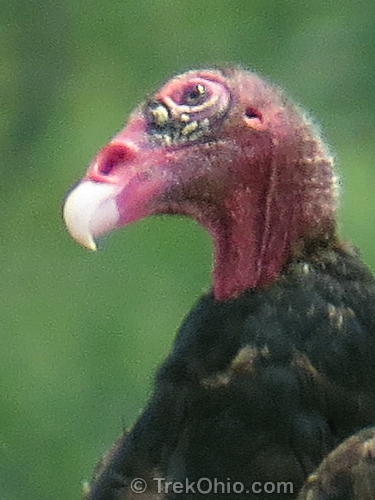
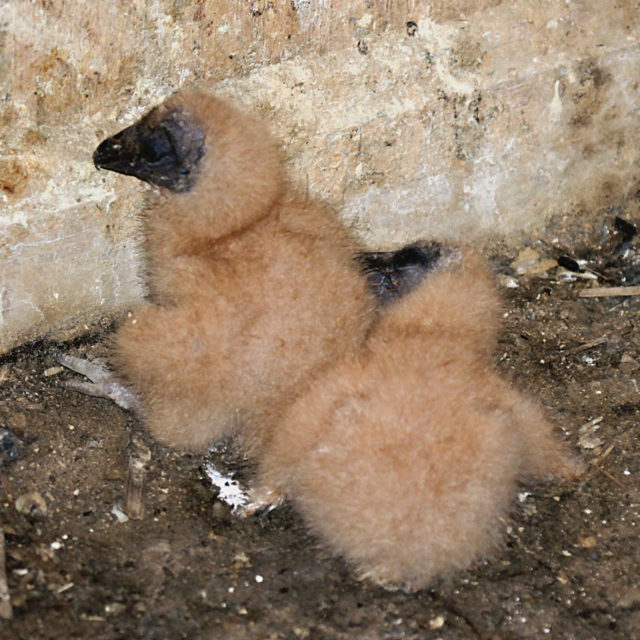
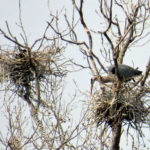
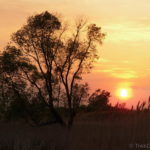
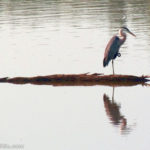
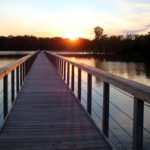
Great Article – I currently have 3 of the Black Vultures sitting on my roof in southern Ohio (Dayton Area). Before finding this I only thought there were the turkey variety.
Just saw black headed vultures for the first time on Wally Rd. in Loundonville, Ohio. Got some good pix and just sat and watched the flock. Totally awesome!
I believe there are black vultures roosting near the Longaberger Eco Park Campus in Frazeysburg Ohio. They are next to a small herd of cattle. I worry about the calves each time I see those birds.
Driving on Scranton Rd in Cleveland 5/26/2016 I saw a large black bird and thought it was strange, I pulled over to take a picture of it but it flew away. This bird was a Turkey Vulture. Is it strange for this bird to be here in Cleveland Ohio?
Cheryl, it may come as a surprise to you that since 1957 one of Cleveland’s metroparks has been holding an annual festival dedicated to Turkey vultures. During the winter, turkey vultures migrate southward. However during the middle of March every year, a festival is held to celebrate the vulture’s migratory return to the Cleveland area. It actually sounds like a fun, sort of tongue-in-cheek event. To read more about a past celebration, check out this article at the the Birds & Blooms website, It’s Time for Buzzard Day in Hinckley, Ohio!
Do you know where turkey vultures in Delaware county, Ohio migrate to in winter? Do they go to Florida, and if so what area?
Mia, I am afraid I don’t know their migration destination, or whether they all migrate to the same place. The Wikipedia article on turkey vultures suggest that they migrate “as far as South America.” And according to the Loudoun Wildlife Conservancy, they migrate to Panama and points farther south.
A large snapping turtle was killed on the road in front of our home this weekend. It was heartbreaking. But a venue of vultures came this morning and moved it to the side of the road, and cleaned out everything but the shell. I feel so much better, knowing it fed them.
I had been watching a snapping turtle in a woodland pond for some time. Then one day I discovered that it had died in the water. I think it may have just died from old age, but I’ll never know. When I returned the next day, its remains were gone, so I assume that something must have scavenged it. It is something of a comfort when you realize that scavengers need this food.
Hi Bob,
I wish I had come across this fantastically informative piece of writing. If so, I would not have mistaken our Black Vulture for a Turkey Vulture.
Best regards from southern Texas,
Pit
Excellent post to a well-deserving species, so vital to our environment. I learned so much more than I knew! I just had a turkey and a black vulture below my balcony not too long ago, devouring a big dead fish. I did not know the black vulture could not smell so now I know why my turkey vulture was there first!
Wonderful post!! Fascinating creatures, and such an integral part of the natural cycle….
Thank You for this nature lesson. They are unknown to me and now I have an idea about them.
I’m given to understand the calves you saw tethered to little shelters are future Veal. I’m not sure the shelters were designed for Vulture defense but I guess that could be true, I think their primary purpose is shade/rain shelter. I’m not too sure how frequent Black Vulture attacks are.
Thanks for the additional info! Despite spending a lot of time driving through rural areas, I had never seen these dog-house-like shelters before. While in Hocking County once, I read an article in a local paper where farmers there were complaining about losses due to black vulture attacks. I know it’s an issue, but I’ve got no statistics that would allow me to gauge the prevalence.
We have a lot of vultures in the area I live in. This post was definitely an eye opener. I knew nothing about the species except that I don’t think they are very charming. It takes all kinds and they are part of my eco system so this was a good post for me in particular. Thank you again for this I can very much refer to again and again. It is not pleasant but I should have a better understanding of what goes on around me.
Thanks, Patricia. I learned a lot about vultures while researching this, some of it not pleasant. But I agree, it takes all kinds. And despite some of their less-than-charming qualities, they sure are beautiful in flight.